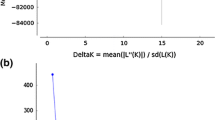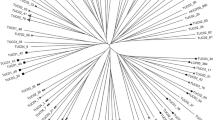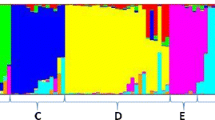Abstract
Association mapping in multiple segregating populations (AMMSP) combines high power to detect QTL in genome-wide approaches of linkage mapping with high mapping resolution of association mapping. The main objectives of this study were to (1) examine the applicability of AMMSP in a plant breeding context based on segregating populations of various size of sugar beet (Beta vulgaris L.), (2) compare different biometric approaches for AMMSP, and (3) detect markers with significant main effect across locations for nine traits in sugar beet. We used 768 F n (n = 2, 3, 4) sugar beet genotypes which were randomly derived from 19 crosses among diploid elite sugar beet clones. For all nine traits, the genotypic and genotype × location interaction variances were highly significant (P < 0.01). Using a one-step AMMSP approach, the total number of significant (P < 0.05) marker-phenotype associations was 44. The identification of genome regions associated with the traits under consideration indicated that not only segregating populations derived from crosses of parental genotypes in a systematic manner could be used for AMMSP but also populations routinely derived in plant breeding programs from multiple, related crosses. Furthermore, our results suggest that data sets, whose size does not permit analysis by the one-step AMMSP approach, might be analyzed using the two-step approach based on adjusted entry means for each location without losing too much power for detection of marker-phenotype associations.



Similar content being viewed by others
References
Andersen JR, Lübberstedt T (2003) Functional markers in plants. Trends Plant Sci 8:554–560
Barzen E, Mechelke W, Ritter E, Seitzer JF, Salamini F (1992) RFLP markers for sugar beet breeding: chromosomal linkage maps and location of major genes for rhizomania resistance, monogermy and hypocotyl colour. Plant J 2:601–611
Barzen E, Mechelke W, Ritter E, Schulte-Kappert E, Salamini F (1995) An extended map of sugar beet genome containing RFLP and RAPD loci. Theor Appl Genet 90:189–193
Beavis WD (1994) The power and deceit of QTL-experiments: lessons from comparative QTL studies. In: 49th annual corn and sorghum industry research conference. American Seed Trade Association, Washington, DC, pp 250–266
Blanc G, Charcosset A, Mangin B, Gallais A, Moreau L (2006) Connected populations for detecting quantitative trait loci and testing for epistasis: an application in maize. Theor Appl Genet 113:206–224
Boer MP, Wright D, Feng L, Podlich DW, Luo L, Cooper M, van Eeuwijk FA (2007) A mixed-model quantitative trait loci (QTL) analysis for multiple-environment trial data using environmental covariables for QTL-by-environment interactions, with an example in maize. Genetics 177:1801–1813
Bouchez A, Hospital F, Causse M, Gallais A, Charcosset A (2002) Marker-assisted introgression of favorable alleles at quantitative trait loci between maize elite inbred lines. Genetics 162:1945–1959
Breseghello F, Sorrells ME (2006) Association mapping of kernel size and milling quality in wheat (Triticum aestivum L.) cultivars. Genetics 172:1165–1177
Burba M, Puscz W (1976) Über die Verwendung von Aluminiumsalzen an Stelle von basischen Bleiacetaten zur Klärung von kalten wäßrigen Breiextrakten der Rübe. Z Zuckerindustrie 26:249–251
Cai D, Kleine M, Kifle S, Harloff H-J, Sandal NN, Marcker KA, Klein-Lankhorst RM, Salentijn EMJ, Lange W, Stiekema WJ, Wyss U, Grundler FMW, Jung C (1997) Positional cloning of a gene for nematode resistance in sugar beet. Science 275:832–834
Chen L, Storey JD (2006) Relaxed significance criteria for linkage analysis. Genetics 173:2371–2381
Cockerham CC, Zeng Z-B (1996) Design III with marker loci. Genetics 143:1437–1456
Crepieux S, Lebreton C, Servin B, Charmet G (2004) Quantitative trait loci (QTL) detection in multicross inbred designs: recovering QTL identical-by-descent status information from marker data. Genetics 168:1737–1748
Curnow RN (1988) The use of correlated information on treatment effects when selecting the best treatment. Biometrika 75:287–293
El-Mezway A, Dreyer F, Jacobs G, Jung C (2002) High-resolution mapping of the bolting gene B of sugar beet. Theor Appl Genet 105:100–105
Emrich K, Wilde F, Miedaner T, Piepho H-P (2008) REML approach for adjusting the Fusarium head blight rating to a phenological date in inoculated selection experiments of wheat. Theor Appl Genet 117:65–73
Falconer DS, Mackay TFC (1996) Introduction to quantitative genetics, 4th edn. Longman Group Ltd, London
Flint-Garcia SA, Thornsberry JM, Buckler ES (2003) Structure of linkage disequilibrium in plants. Annu Rev Plant Biol 54:357–374
Gilmour AR, Gogel BJ, Cullis BR, Thompson R (2006) ASReml User Guide Release 2.0 VSN International Ltd, Hermel Hempstead, UK
Holm S (1979) A simple sequentially rejective multiple test procedure. Scand J Stat 6:65–70
Jung C, Hohmann U (2006) Establishment of a TILLING platform for sugar beet. In: Proceedings of the 14th plant and animal genome conference, San Diego
Kraakman ATW, Niks RE, Van den Berg PMMM, Stam P, Van Eeuwijk FA (2004) Linkage disequilibrium mapping of yield and yield stability in modern spring barley cultivars. Genetics 168:435–446
Lander ES, Botstein D (1989) Mapping mendelian factors underlying quantitative traits using RFLP linkage maps. Genetics 121:185–199
Lewis PO, Zaykin D (1999) Genetic data analysis. Computer program for the analysis of allelic data. Version 1.0.
Lynch M, Walsh B (1998) Genetics and analysis of quantitative traits. Sinauer Assoc., Sunderland
Melchinger AE (1988) Means, variances, and covariances between relatives in hybrid populations with disequilibrium in the parent population. In: Weir BS, Eisen EJ, Goodman MM, Nomkoong G (eds) Proceedings of the 2nd international conference on quantitative genetics. Sinauer Associates, Raleigh, pp 400–415
Melchinger AE, Utz HF, Schön CC (1998) Quantitative trait locus (QTL) mapping using different testers and independent population samples in maize reveals low power of QTL detection and larger bias in estimates of QTL effects. Genetics 149:383–403
Moreau L, Charcosset A, Gallais A (2004) Use of trail clustering to study QTL × environment effects for grain yield and related traits in maize. Theor Appl Genet 110:92–105
Ozaki K, Ohnishi Y, Iida A, Sekine A , Yamada R, Tsunado T, Sato H, Hori M, Nakamura Y, Tanaka T (2002) Functional SNPs in the lymphotoxin-α gene that are associated with susceptibility to myocardial infarction. Nat Genet 32:650–654
Palaisa K, Morgante M, Tingey S, Rafalski A (2004) Long-range patterns of diversity and linkage disequilibrium surrounding the maize Y1 gene are indicative of an asymmetric selective sweep. PNAS (USA) 101:9885–9890
Piepho H-P (2000) A mixed model approach to mapping quantitative trait loci in barley on the basis of multiple environment data. Genetics 156:253–260
Piepho H-P, Möhring J (2007) On weighting in two-stage analyses of series of experiments. Biul Oceny Odmian 32:109–212
Piepho H-P, Pillen K (2004) Mixed-modelling for QTL × environment interaction analysis. Euphytica 137:147–153
Piepho H-P, Williams ER, Fleck M (2006) A note on the analysis of designed experiments with complex treatment structure. HortScience 41:446–452
Pillen K, Steinrücken G, Wricke G, Herrmann RG, Jung C (1992) A linkage map of sugar beet (Beta vulgaris L.). Theor Appl Genet 84:129–135
Pillen K, Steinrücken G, Wricke G, Herrmann RG, Jung C (1993) A extended linkage map of sugar beet (Beta vulgaris L.) including nine putative lethal genes and restorer gene X. Plant Breed 111:265–272
Rebai A, Goffinet B (1993) Power of tests for QTL detection using replicated progenies derived from a diallel cross. Theor Appl Genet 86:1014–1022
SAS Institute (2004) SAS Version 9.1. SAS Institute, Cary
Schneider K, Schäfer-Pregl R, Borchardt DC, Salamini F (2002) Mapping QTLs for sucrose content, yield and quality in a sugar beet population fingerprinted by EST-related markers. Theor Appl Genet 104:1107–1113
Schön CC, Utz HF, Groh S, Truberg B, Openshaw S, Melchinger AE (2004) Quantitative trait locus mapping based on resampling in a vast maize testcross experiment and its relevance to quantitative genetics for complex traits. Genetics 167:485–498
Searle SR, Casella G, and McCulloch CE (1992) Variance components. Wiley, New York
Smith A, Cullis B, Gilmour A (2001) The analysis of crop variety evaluation data in Australia. Aust N Z J Stat 43:129–145
Stich B, Yu J, Melchinger AE, Piepho H-P, Utz HF, Maurer HP, Buckler ES (2007) Power to detect higher-order epistatic interactions in a metabolic pathway using a new mapping strategy. Genetics 176:563–570
Stich B, Möhring J, Piepho H-P, Heckenberger M, Buckler ES, Melchinger AE (2008) Comparison of mixed-model approaches for association mapping. Genetics 178:1745–1754
Utz HF, Melchinger AE (1994) Comparison of different approaches to interval mapping of quantitative trait loci. In: Van Ooijen JW, Jansen J (eds) Biometrics in plant breeding: applications of molecular markers. Proceedings of the ninth meeting of the EUCARPIA section biometrics in plant breeding. CPRO-DLO, Wageningen, Netherlands
Weber WE, Borchardt DC, Koch G (1999) Combined linkage maps and QTLs in sugar beet (Beta vulgaris L.) from different populations. Plant Breed 118:193–204
Weber WE, Borchardt DC, Koch G (2000) Marker analysis for quantitative traits in sugar beet. Plant Breed 119:97–106
Weir BS (1996) Genetic data analysis II, 2nd edn. Sinauer Associates, Sunderland
Wilson LM, Whitt SR, Ibáñez AM, Rocheford TR, Goodman MM, Buckler ES (2004) Dissection of maize kernel composition and starch production by candidate gene association. Plant Cell 16:2719–2733
Yu J, Buckler E (2006) Genetic association mapping and genome organization of maize. Curr Opin Biotechnol 17:155–160
Yu J, Holland JB, McMullen MD, Buckler ES (2008) Genetic design and statistical power of nested association mapping in maize. Genetics 178:539–551
Acknowledgments
This research was conducted within the Breeding and Informatics (BRAIN) project of the Genome Analysis of the Plant Biological System (GABI) initiative (http://www.gabi.de). The authors appreciate the editorial work of Dr. J. Muminović, whose suggestions considerably improved the style of the manuscript. The authors thank two anonymous reviewers for their valuable suggestions.
Author information
Authors and Affiliations
Corresponding author
Additional information
Communicated by F. van Eeuwijk.
Appendix
Appendix
Statistical models with random effects for genotypes can be used in AMMSP approaches to model the relatedness among genotypes. In this context it is assumed that
where g is the vector containing the genotypic effects of all entries and A is the numerator relationship matrix. However, in AMMSP studies in which marker data are not available for all entries, separate genotypic effects have to be assumed for entries with (g 1) and without (g 2) available marker data:
Assume g 1 = f 1 + h 1, where f 1 is the vector of genotypic effects of the marker locus under consideration, then:
where p g is the proportion explained genotypic variance of the marker locus under consideration, G = p g A 11, H = (0 p g A 12), and
Based on the formulas for the conditional multivariate normal distribution (Searle et al. 1992), it can be concluded that conditioning on f 1 leads to:
where
and
Under the assumption that conditioning on a marker locus is equivalent to conditioning on f 1, this result suggests that in the conditional density of all entries, the expected value of the entries without available marker data is shifted by conditioning on the marker data of the entries with available marker data. This problem can be overcome by replacing f 1 by a regression approach on the marker \(({\bf f}_1={\bf X}_1{\varvec{\alpha}}),\) which leads to:
and
where X 2 = A 21 A −111 X 1 and \(\sigma_{\check{g}}^2 =(1-p_g)\sigma_{g}^2.\)
Rights and permissions
About this article
Cite this article
Stich, B., Melchinger, A.E., Heckenberger, M. et al. Association mapping in multiple segregating populations of sugar beet (Beta vulgaris L.). Theor Appl Genet 117, 1167–1179 (2008). https://doi.org/10.1007/s00122-008-0854-8
Received:
Accepted:
Published:
Issue Date:
DOI: https://doi.org/10.1007/s00122-008-0854-8




